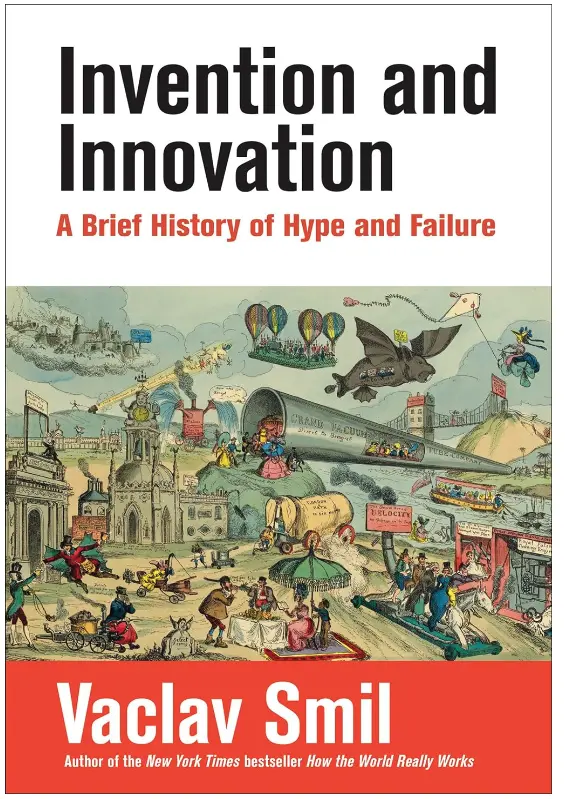Invention and Innovation: Hype and Failure by Vaclav Smil One of Bill Gates's favorite authors
Here is a must-read for you if you're a tech and innovation fan from one of the best writers, Vaclav Smil.

Invention and Innovation, a book by Smil, will give you a picture of the natural world, which differs from what we think. Smil has written almost 44 books, all related to Technologies, Inventions, the Modern World, AI, Human Life, Electric cars, and the various innovations that prevail in this generation of technology and AI. Bill Gates claims to have read all his 44 books and finds them very valuable and informative.

In this book, Smil pens provide an insightful and fact-filled tour of the history of invention. He believes the late nineteenth century was the only era of explosive innovation where our ancestors invented many innovative things that are still in use today. Modern society still depends on perpetuating simple products like hammers and saws, wooden chairs and benches, and cups and plates. However, only a tiny share of their production is now artisanal as machines have taken over.
Machines belong to the second category of inventions, which involve new or more complex devices or mechanisms deployed for stationary use. Large water wheels, windmills, blast furnaces, and ocean-going sailing ships were among the pre-modern inventions in this category. Based on his research and analysis, Smil states that our current era could be more innovative.
Vaclav is very pessimistic about new technologies and inventions, and he's often right when deploying them in the real world because we need to learn more deeply about their difficulties. He concludes that "this growth has no counterpart in other aspects of our life."
What was the invention before the nineteenth century?

In this book, Smil enlightens about various facts and gives many examples of inventions before the nineteenth century.
- The USSR is the most recent example of the distance. Soviet scientists have many notable inventions to their credit. The USSR advanced Forty-Five thousand nuclear warheads. The MIG-29 and SU-25 were among the world's best fighter planes deployed in combat.
- The USSR also excelled in the world's most important energy sector. Soviet scientists discovered enormous hydrocarbon fuels, developed the world's largest oil and gas industry, and built, at the time of their completion, the world's longest pipelines, which supply much of Europe's crude oil and gas needs.
- But by 1991, when the country unraveled, the USSR suffered many innovation gaps, ranging from key primary industries to satisfying basic consumer demand. The country's lagging innovation in the mass production of everyday consumer items, from blue jeans to personal computers, was the perennial cause of public discontent.
Is this an unparalleled era of innovation?
This part is indeed a reality check of the real world. Smil, through his book, has shown that the world in which we are living and what we thought to be is not what it is. Let's explore some facts and examples that will make us face reality.
- Smil claims that we are a fundamentally fossil fuels civilization. Fossil fuels have created everything we have and all the creation around us. He points out that by reading the newspaper, we get the impression that we are very advanced in our way, running far away from fossil fuels, but 85% of modern commercial energies come from fossil fuels. And in 2000, 90% were, so we have traveled 5% down the route in the past generation. And even if we double the rate, we shall remain a fossil fuel civilization for a long time.
- Smil shockingly states, "There are no such things as electric cars." He says that there are cars in the world that have electric motors.
- He also points out that only four jurisdictions, like Britain, Columbia, Norway, and Quebec, have hydroelectric cars and no carbon. If it's in China, it's a coal car, and if it's in France, it's a nuclear car, and it goes down the list as long as fossil fuels produce the world's electricity. He claims that there is much more traffic and emissions for future generations.
Let's have a look at some successful failures.
Smil states that he's not concerned about the numerous design failures that resulted in catastrophic events, including such widely known tragedies as the Titanic 1912 sinking and the Challenger 1986 launch disaster.
Historians of technical advances have detailed many failures dealing with hopeless designs such as electric plows in pre-World War I Germany or automotive gas turbines, and the recent reviews of Apple 12 most embarrassing product failures, from Mac and touch TV to the power Mac G-4 Cube.
Tesla's world system of wireless electricity distribution and some recent delusions, such as un-nuclear electro-powered bombers, are inevitable, and these failures of engineers, objects, and systems offer great lessons about what to avoid and correct.
Smil gives some other examples of failed innovations whose initial promise appears to ensure the eventual domination of their respective markets. Airships are for affordable long-distance air transport, nuclear fission is for electricity generation, and supersonic aircraft are for speedy inter-continental travel. Airships and atomic fission were commercialized and more or less widely deployed, but it took a little while to realize that they would not reach their initial help for potential.
Chronologically, airships failed for the first practical application. Nuclear fission is a case of mis-expectation on a larger scale, and it has been the foremost example of the phenomenal icon's successful failure. Despite its considerable commercial deployment with more than four hundred reactors operating on three continents and its significant contribution to electricity generation in several affluent countries, its current global market share still needs to catch up with the expectations given of this complex technique in the early phase of its enthusiastic adaptation.
Furthermore, he states that the world is changing to potential, everything from food to longevity and energy to travel. We have reduced the number of malnourished people to less than a tenth of the global population. So why not illuminate food shortages entirely and severely our dependence on fuel crafts by producing food in climate-regulated high rises or swallowing synthetic rise capsules to complete nutrition?
Rich countries have multiplied themselves at a different rate as a proper per capita energy supply. So why not keep expanding even as we eliminate all fossil carbon as an energy source by ingeniously converting all energy sources?
However, one does not have to be a disciple of the approaching singularity because even more mundane claims are impressive and announce breakthroughs in different diseases.
These drugs supposedly cure Alzheimer's disease, store electric energy, invent an unheard-of energy density, and even convert planets into habitable Worlds. The realities have been far less exalted, and this book is a modern reminder of the world as it is, not the world of exaggerated claims.
Also read the following:


Share and subscribe to the blog by email.





Comments ()